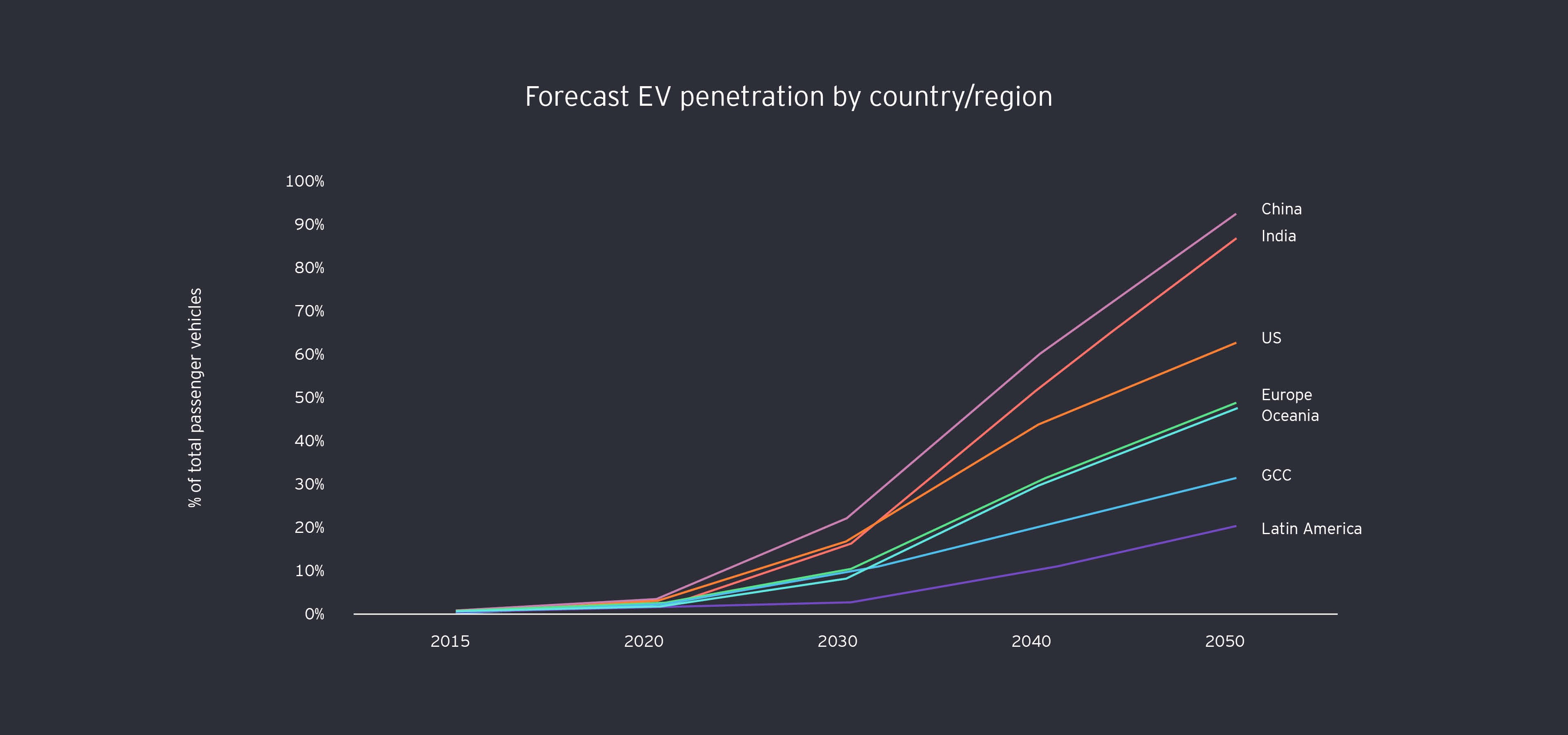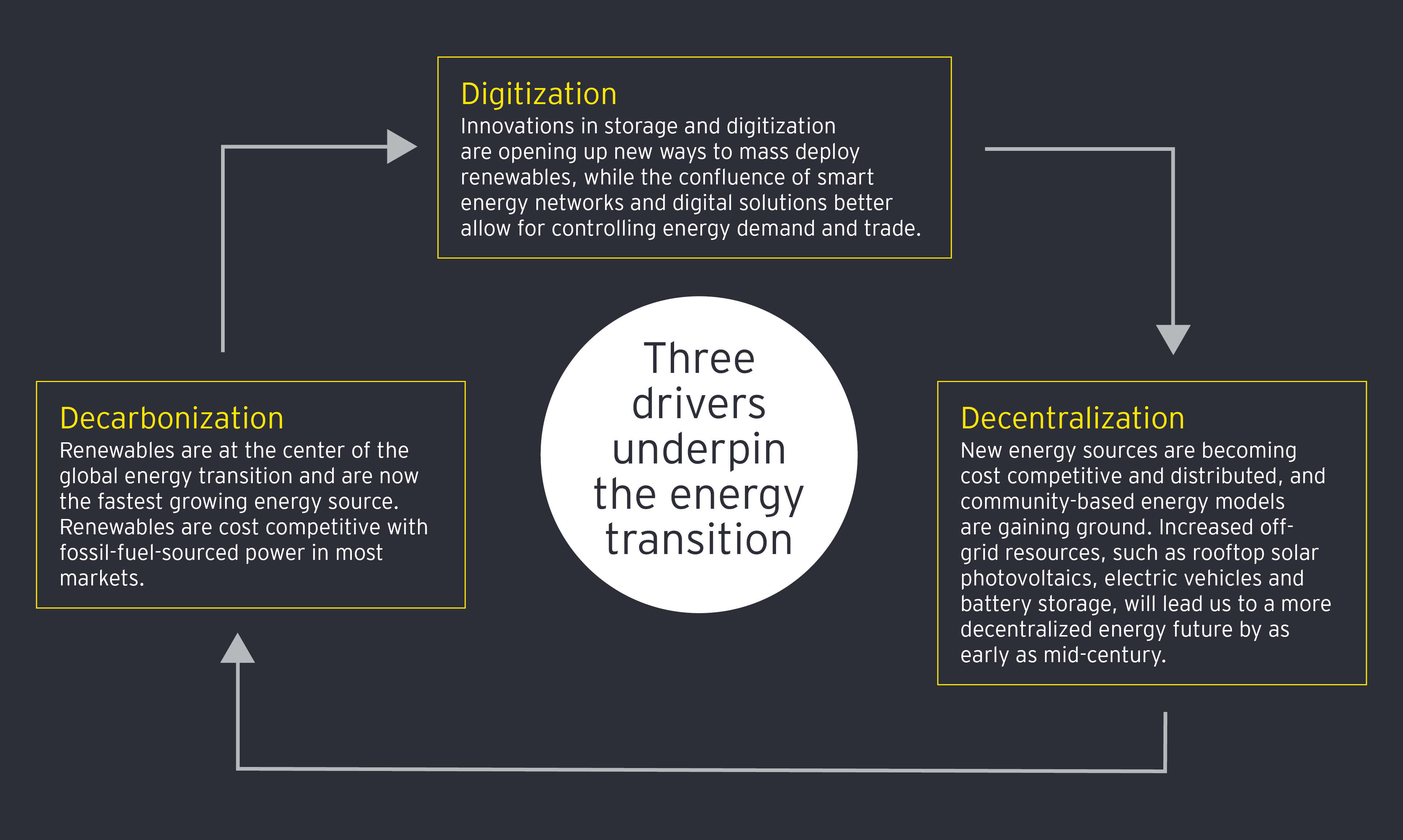
Chapter 1
Four forces accelerating change
A combination of factors is creating a compressed timeline to a new energy world.
Our latest research indicates that there are drivers of growth which are progressing faster than even the most ambitious estimates, bringing forward the tipping points in some markets by as much as two years. This accelerated pace is driven by four key forces.
Force 1: Better, cheaper technology
Since 2009, the cost of solar photovoltaics (PV) modules and wind turbines have plunged by about 80% and 30% to 40%, respectively, while the performance of both technologies has seen huge improvements. As a result, solar and wind resources now offer economically viable alternatives to new fossil fuel-sourced generation and are being deployed on a mass scale.
Indeed, 2018 was the seventh year in a row where new renewable energy capacity outstripped new conventional energy installations. With prices set to fall, particularly for solar and wind power technologies, the cost advantage of renewables will extend further. As early as next year, onshore wind and solar PV will be a less expensive source of new electricity than the cheapest fossil fuel alternative.
This accelerating shift toward utility-scale renewables, complemented by declines in the cost of decentralized generation-plus-storage solutions, has created problems for electricity networks. With limited visibility into behind-the-meter assets, networks have struggled to forecast and control their grids and have often had to impose constraints or make costly capital investments in the absence of data.
But now, improvements in grid operation and advancing technology are helping to overcome these challenges. New digital platforms are creating open digital energy marketplaces that allow the secure dispatch of distributed energy services across businesses, households, communities and energy companies.
Other technologies that supercharge the potential of renewables have also moved from emerging trends to integral parts of the energy system in record time.
- Battery storage may be the biggest disrupter to the energy sector: Globally, the advanced energy storage market is forecast to grow from an annual installation size of 6GW in 2017, to over 40GW by 2022.1 In some markets, the improved performance and decreasing costs of batteries are already seeing them displace natural gas from the energy mix. Late last year, two US utilities — PG&E and APS — announced they would replace natural gas power plants with battery storage.
- Artificial intelligence (AI) and machine learning are redefining many aspects of energy companies’ operations: AI applications have been adopted within electricity generators, across power grids and by energy retailers to improve operations and bring entirely new capabilities. For example, GE is using AI to improve wind turbine efficiency by correlating weather patterns with turbine operation data to predict output up to a week in advance. US startup SparkCognition uses a combination of machine learning algorithms, sensors and operational data to predict when critical infrastructure will fail.
- Peer-to-peer (P2P) electricity trading is maturing: Once limited to small pilots, P2P energy trading platforms are now being commercially deployed by both new innovators, such as Australia’s Power Ledger, and major utilities, including EDF, AGL, Origin Energy and Kansai Electric. In Lithuania, startup WePower has built a decentralized marketplace that enables renewable energy prosumers to transact electricity among each other, removing the need for a middleman.
While it’s the combination of technologies that is speeding up our journey to the tipping points and advancing the ability to securely operate the grid with high shares of variable renewables, battery innovation is probably the most influential. In particular, the adoption of utility-scale storage in the US marks a major turning point that will drive momentum in other regions. We expect these developments to have flow-on effects on the economics of smaller-scale, behind-the-meter battery technologies around the world.
Many strategic corporate sponsors are looking to stay ahead of disruptive trends by launching internal venture capital funds. Large integrated players, such as ENGIE, EDF, National Grid and Exelon, all have venture capital funds with investments in digital, transportation and behind the meter. This will launch a new frontier of competition with established venture capital funds working in the clean energy ecosystem.
Force 2: Policy revisions and more ambitious clean energy targets
A revolution in the power sector is driving rapid change toward a renewable energy future, spurred by a combination of targeted public policy and advances in energy technologies. As technologies and markets mature, countries are increasingly moving away from some of the policy mechanisms that drove early uptake in renewables. While feed-in policies remain the backbone of national support schemes, renewable tenders are increasingly prominent.
A revolution in the power sector is driving rapid change toward a renewable energy future, spurred by a combination of targeted public policy and advances in energy technologies.
Around the world, governments are also revising renewable energy targets, with many mandating big increases that are radically — and quickly — shifting their country’s energy mix. And, in those markets where national governments are slower to act, state and local authorities are taking matters into their own hands.
- Almost 60 countries have developed plans that will completely decarbonize their electricity sector.²
- 179 countries have set national or state-level clean energy targets.³
- China plans to raise its renewable energy target from 20% to 35% by 2030.
- India’s national electricity plan sets out a renewable target of 275GW by 2027. After setting an initial interim target of 175GW by 2022, this has now been revised to 227GW.
- In the US, renewable energy made up almost 18% of total electricity generation in 2018, compared to around 10% a decade earlier, with coal dropping from 48% to 28% over the same period.4 And, in May, Washington became the fifth US state/territory to commit to 100% renewable energy and at least another six are considering doing the same. States in the Northeast and Mid-Atlantic US are setting specific offshore wind targets to develop a market similar to that of Europe.
- Five of Australia’s eight states and territories, disappointed by the country’s ongoing energy policy uncertainty, have set renewable energy targets, and all have progressed clean energy initiatives.
- Saudi Arabia has set a clean energy target of 58.7GW by 2030 – a massive jump from the previous 9.5GW goal.
These policy mechanisms have been critical in beginning the world’s move to cleaner sources of energy — but a shift is now taking place. The next wave of action is coming from the energy industry itself, where companies are taking a proactive role in setting their own renewable energy targets, driven by the impact on their business and rising customer and stakeholder expectations.
Force 3: The distributed generation trend is gaining momentum, especially among corporates
A powerful mix of consumer demand, sustainability targets and a desire to cut costs and secure energy supply is pushing companies to forge their own power purchase agreements (PPAs) or self-generate electricity. More corporates than ever bought clean energy last year, and not just big companies. Many smaller businesses are entering the market for the first time.
For many businesses, the main driver is an economic one, as significant reductions in renewable energy costs, as well as maturing market and policy environments, have made renewables cost competitive and attractive sources of energy in their own right. Many regions face steep rises in electricity bills as cost pressure intensifies on grid-supplied electricity. In some countries, including Argentina, Egypt and Saudi Arabia, plans are underway to roll back the subsidies that keep electricity prices artificially low. And, in almost all markets, transmission and distribution (T&D) costs are forecast to increase.
This is because of a need to expand networks to meet rising demand, replace aging network infrastructure and invest in digital technologies to smarten the networks — indeed, the pressure from growing network costs is reflected in our tipping points model. Between now and 2050, the US Northeast T&D costs are set to rise an average 7% per annum; Europe and Oceania costs will increase an average 3.6% per annum; and emerging markets, including China and Latin America, will see an increase of 3.9% per annum. PPA contracts that run for 10 or more years offer a great hedge in the face of these expected rises.
But motivation is not purely around direct costs. In a world where consumers increasingly factor in a company’s green credentials before making a purchase, more companies are pursuing PPAs for reputational reasons. PPAs are more attractive than buying green tariffs, as they offer a direct link to a particular project.
Meanwhile, the uptake of solar PV at a residential level continues to accelerate beyond expectations and community energy schemes are on the rise, impacting energy companies’ market share.
- According to a study of 2,400 large global companies by the International Renewable Energy Agency (IRENA)5 in 2018, renewables are a “mainstream pillar of business strategy.”
- More than 200 of these companies get at least half of their energy from renewables; 50 are totally powered by renewables.
- Corporate renewable energy sourcing has moved beyond the US and Europe and is now found in countries such as Chile, China, Egypt, Ghana, India, Japan, Mexico, Namibia and Thailand.6
- Australia now boasts more than two million rooftop solar systems.
- In Mexico, one of Latin America’s leading markets for solar PV, adoption rates are climbing higher than forecasters can keep up.
- US solar installations have also topped two million, equivalent to more than 70GW of capacity, with residential systems making up 96% of this total.
- In California, almost eight million households participate in community energy schemes.
The number of households generating and storing electricity will continue to climb, but it’s the business-to-business distributed generation movement that will be the real game changer. The impact of corporates embracing renewables will hit energy companies hard within a far shorter time frame, bringing the tipping points forward in some markets.
The business-to-business distributed generation movement will be the real game changer. The impact of corporates embracing renewables will hit energy companies hard within a far shorter time frame, bringing the tipping points forward in some markets.
Force 4: Stakeholder action is reshaping energy investment
The entire funding landscape of the energy sector, including the who, how and why, has completely shifted in only a few years. This is partly due to the changing nature of energy assets. Renewables and energy technologies are attracting new types of funders, including private equity firms and venture capitalists, who seek investments with smaller time frames and bigger potential for innovation. But perhaps of greater impact is the rise of the activist shareholder. Pressure from investors, as well as regulators, customers and the public, is demanding companies to focus on cleaner sources of electricity:
- Low-carbon energy sources now attract 70% of global power generation funding.
- More than 95% of power sector investments now rely on regulations or contracts beyond short-term wholesale markets for their main remuneration.
- At the 2018 United Nations Climate Change Conference, 415 investors with a cumulative US$32t under management (pdf) demanded countries and companies implement the Paris Agreement, stating that doing so will “see significant economic benefits and attract increased investment that will create jobs in industries of the future.”
- Competitive mechanisms account for around 35% of global investment in utility-scale renewable generation.
The investment momentum toward cleaner energy is growing stronger every day. In fact, global capital is “fleeing” thermal coal, according to a recent report from the Institute for Energy Economics and Financial Analysis. It reported that more than 100 global financial institutions over the past six years have announced they will no longer invest in these projects.
There is a growing appetite among investors for environmental, social and governance (ESG) investment. In 2019, Vanguard announced the launch of an actively managed Global ESG Fund with a strategy of selecting companies that integrate leading ESG practices into their corporate strategies.

Chapter 2
The electrification of everything
By 2050, we’ll need to source half of our energy from renewably generated electricity.
Together, these four forces are transforming our world into one where cleanly generated electricity powers almost every aspect of our lives.
Electricity has been the fastest-growing energy source since 2000 but, by 2050, will need to make up almost 50% of total final energy consumption if our cities are to cope with a growing trend toward urbanization.7 By that time, about 67% of the world’s population will live in urban areas. The electrification of buildings, heating, industry, data centers and transport will be a critical lever in building sustainable, climate-safe cities.
Electric vehicles (EVs) are already an integral part of many countries’ drive to reduce emissions and "create urban mobility networks" that can cater to growing populations. More governments have boosted support for EVs that, together with falling prices and better performance, is driving greater uptake across key energy markets.
- Fourteen countries have announced bans on the sale of internal combustion engine (ICE) vehicles, with Denmark the latest banning ICE sales from 2030. Europe leads ICE phaseout efforts by far. Austria, Denmark, France, Germany, Ireland, the Netherlands, Norway and the UK have all set dates to ditch new fossil fuel car sales. Portugal and Spain, meanwhile, offer EV incentives.
- Sales of EVs are expected to reach 57% of global vehicle sales by 2040, according to BloombergNEF Electric Vehicle Outlook 2019. Thirty-three percent of the global car fleet will be electric, reaching price and performance parity with ICEs as early as the mid-2020s.
- Energy sector attendees at EY Innovation Realized 2019 told us that EVs will be the industry’s biggest game changer within the next 10 years, as well as their biggest revenue growth opportunity.

For energy companies, adapting to the electrification of transport and its impact on system load, peak demand and storage potential will be critical to their future. Now is the time to consider just how to play a role in this new world: doing nothing is not an option. And competition, both from energy companies and others, to stake early claims in this market is intensifying. Already, we see oil and gas companies, including BP, Total and Shell, diversifying into EVs and investing in infrastructure, renewables and advanced battery technologies. Total, as part of its commitment to become a Responsible Energy Major, has set an ambition to develop a portfolio of renewable power generation assets — solar, wind and hydro. Shell, similarly, is staking big claims in the electrification trend, announcing its ambition to be the world’s biggest electricity company by 2030.
For energy companies, adapting to the electrification of transport and its impact on system load, peak demand and storage potential will be critical to their future. Now is the time to consider just how to play a role in this new world: doing nothing is not an option.

Chapter 3
Four actions can fulfill the potential of our new energy world
Time is short to make critical changes to all aspects of the energy system.
As the journey to a decarbonized, electrified world speeds up, the urgency to act is intensified. Four key actions on the part of all energy stakeholders are critical if the transition is to achieve its potential.
1. Energy companies must move faster to transform
Energy companies are not keeping up with the pace of change. Time is running out to gain the new capabilities — and a mindset — that will be key to success:
- Generators must adopt a two-pronged strategy. First, cut costs to remain competitive as grid parity looms. Second, play to other strengths that carve out a new role. For example, the ability to provide a reliable, secure and diverse supply of electricity will be of increasing value in a distributed energy world. Already, leading generators are putting their deep sector knowledge to use to play a central role in the growth of the electrification of transport, storage and microgrids. Owners and operators of generation plants that partner with developers that are flexible in providing both centralized and decentralized solutions will enjoy distinct advantages in the future energy world. Transnational developers, such as Enel Green Power, EDF Renewables and AES Corporation, have growing portfolios of utility-scale, microgrid and distributed renewable resources.
- Networks must rethink their entire role. The days of facilitating simple, one-way energy flows are long gone. Network companies must consider instead how to build a new type of network operator that integrates and optimizes a multi-directional flow of supply and demand from multiple sources. This requires gaining key capabilities, including the active management of dynamic real-time activity across the network, while still maintaining adequate physical capacity to meet demand.
- Retailers will be without a viable business model sooner rather than later as consumers, particularly those in business, become increasingly self-reliant and less dependent on the grid for energy supply. Remaining relevant requires retailers to redefine their relationships with customers, considering how to help, rather than hinder, their renewable energy aims. For example, retailers can provide their expertise to businesses as they build their own solar energy system or choose the right PPA. Leveraging digital capabilities will position companies to offer more innovative energy services, such as tailored demand response programs or power factor correction.
2. Regulators and policymakers must adapt to change
Governments and regulators risk stalling the energy transition if they do not adapt with agility. Moving to a flexible, risk-based regulatory model that balances consumer interests and innovation is needed if energy companies are to transform in time.
Related article
Moving to a flexible, risk-based regulatory model that balances consumer interests and innovation is needed if energy companies are to transform in time.
During 2019, California will enact a wide-scale rollout of time of use (TOU) rates across 20 million customers. Pilot programs are ongoing across the US to determine the effectiveness of TOU.
Accelerating EV adoption will require going beyond incentivizing customers to buy cleaner cars. Rewarding energy companies for playing their role in driving the shift to electrified transport demands urgent policy updates, as seen in more forward-looking regions. In Arizona, policymakers now allow utilities to recover investment in EV charging infrastructure through rates.
Helping energy companies shift their business models from those purely based on selling as much electricity as possible requires new ways to reward performance. Regulators should consider revenue decoupling, which separates an energy company’s sales from its revenues and profits. Rates of return are aligned with revenue targets, and rates are adjusted accordingly to meet the target at the end of the adjustment period. This improves the case for deploying energy efficiency and distributed generation solutions, as the operating environment becomes less incentivized to expand traditional energy sales.
Performance-based regulation (PBR) must also be explored as a tool to better incentivize utility investment in distributed generation, energy efficiency and demand-side management solutions. Globally, the most common form of PBR is multiyear rate plans (MRPs), which feature a moratorium on rate cases for several years — frequent rate cases are associated with poorer performance and higher customer costs.
MRPs balance incentives for cost containment with incentives to strengthen performance in targeted areas, which may include utility conservation programs focused on smart grid innovation, distributed generation and energy efficiency. Prominent examples include the UK’s RIIO8 and New York’s Reforming the Energy Vision; but, we also see leading MRPs in Australia, Germany, the Netherlands and New Zealand, and discussions around PBRs are ongoing in several US states, including California, Hawaii, Illinois, Ohio and Pennsylvania.
3. New financing models must encourage investment in new energy solutions
The true innovation seen across the energy sector is yet to make much of an impact on the financing structure that funds it. But, as the energy transition amplifies the risk of diminishing returns to traditional investors, finding new sources, and models, of funding is critical.
Energy companies must explore new investment models that share risk and rewards and encourage collaboration. For example, shared risk ownership models allow technology developers or other third parties to own and operate assets in partnership with the local utility. Those with real foresight could offer 100% clean power to customers, including corporate buyers, taking on the complexities around price and supply risk.
Others may follow the lead of those energy companies that have already established venture capital funds to pursue innovation.
And, almost all must consider how to join forces with players within the wider energy ecosystem. Private equity and infrastructure funds have record levels of dry powder9 ready to deploy into the market. Funding the energy infrastructure and networks fit for the future will be a team effort.
4. Collaboration is necessary for innovation
All stakeholders in our energy system must realize that the challenges of the sector cannot be solved in isolation. When industry players, regulators, governments and companies in adjacent sectors work together, there is greater potential to unlock the innovation needed to address the most complex energy challenges.
For example:
- Partnering with technology companies can help utilities better leverage digital innovation — Southern California Edison has collaborated with Google Nest thermostats to roll out a residential demand response scheme that helps balance the grid on hot summer days.
- Working with automakers is a natural fit — Sweden’s Vattenfall has partnered with Volvo to deliver, install and service EV charging boxes.
- Better meeting the specific energy needs of corporate customers requires a sophisticated understanding of commercial and industrial energy management — Enel acquired US company EnerNOC to position Enel X as a leader in this space.
- Building smart, sustainable cities requires energy companies and governments to work hand in hand – Spanish renewable energy giant ACCIONA joined forces with the Madrid City Government to implement a city-wide energy management system across 400 municipal buildings.
But sector convergence and the digitization of energy open up almost endless opportunities for nontraditional collaborations. Energy companies must take an open-minded approach to partnerships, considering how best to combine knowledge, skills and customer bases to tap new revenue streams.
Embracing flexibility may be the best strategy
Will the tipping points move even closer when we next update our analysis? The answer is probably yes, given the faster than expected evolution of the energy sector so far, particularly regarding the decentralization of electricity generation. A compressed countdown to transformation amplifies pressure on energy companies, regulators and other stakeholders to be ready in time. Time is short to transform businesses, reform regulation, develop new financing models and build the cross-industry collaborations that will solve the most complex energy challenges.
But, while navigating the brave new energy world requires a robust strategy, perhaps the best approach is to embrace flexibility. Exploring different possible futures, the levers that influence them and the interactions that arise within a complex energy system is critical to survival.
The clock is ticking.
Summary
Four key forces are accelerating the countdown to the critical tipping points that will change the energy sector forever. Energy companies must move faster if they are to be ready in time. Gaining the right capabilities will be critical, but so too will be the ability to move with agility to seize opportunities as they emerge.


